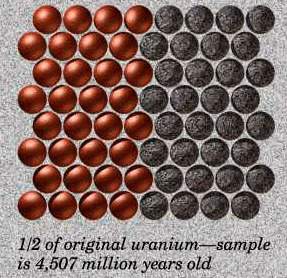
 Clues from Radioactivity
Clues from Radioactivity
There are two main methods for dating rocks. Relative dates are determined in part by the position of the rocks (in undisturbed layers, older rocks are on the bottom) and by index fossils in the rocks. Relative dates only indicate if the rocks are older, younger, or the same age as something else.
Radiometric dates provide an estimate of the age in years. This method can only be used on igneous rocks or rocks that contain volcanic ash or igneous intrusions. Radioactive forms of some elements are unstable and slowly decay into daughter elements at a constant, known rate.
For example, radioactive uranium (U238) decays to lead (Pb206). The time it takes for half of the uranium to change to lead - known as the half-life - is a constant 4,507 million years. By measuring the ratio of Pb206 to U238 in any given sample, scientists can calculate the age of the sample.
Geologists correlate relative ages to radiometric dates to establish a chronology for all rock types.
Rock containing uranium forms
4,507 million years - 1/2 of original uranium left
9,014 million years - 1/4 left
13,521 million years - 1/8 left
18,028 million years - 1/16 left
22,535 million years - 1/32 left